Ledverlichting Soest – LVS C95-LVS-High Bay 180W Osram leds
Posted by Marcel van der Steen in Led lights, Light measurements Add comments presents a highbay led lamp emitting a lot of cold white light.
presents a highbay led lamp emitting a lot of cold white light.
This article shows the measurement results. Many parameters are also found in the Eulumdat file.
See this overview for a comparison with other light bulbs.
Summary measurement data
| parameter | meas. result | remark |
|---|---|---|
| Color temperature | 7180 K | cold white |
| Luminous intensity Iv | 5562 Cd | Measured straight underneath the lamp. |
| Illuminance modulation index | 1 % | Measured straight underneath the lamp. Is a measure for the amount of flickering. |
| Beam angle | 105 deg | 105º for all C-planes as the lamp shows symmetry along the 1st axis. |
| Power P | 179 W | |
| Power Factor | 0.94 | For every 1 kWh net power consumed, there has been 0.4 kVAhr for reactive power. |
| THD | 10 % | Total Harmonic Distortion |
| Luminous flux | 13844 Lm | |
| Luminous efficacy | 77 Lm/W | |
| EU-label classification | B | The energy class, from A (more efficient) to G (least efficient).
In this case the lamp emits more than 6500 lumen and the energy label is not defined. This result is therefore just an indication. |
| CRI_Ra | 69 | Color Rendering Index. |
| Coordinates chromaticity diagram | x=0.3050 and y=0.3097 | |
| Fitting | 230V | This lamp is connected to the 230 V grid voltage. |
| PAR-value | 56.1 μMol/s/m2 | The number of photons seen by an average plant when it is lit by the light of this light bulb. Value valid at 1 m distance from light bulb. |
| PAR-photon efficacy | 0.8 μMol/s/We | The toal emitted number of photons by this light, divided by its consumption in W. It indicates a kind of efficacy in generating photons. |
| S/P ratio | 2.0 | This factor indicates the amount of times more efficient the light of this light bulb is perceived under scotopic circumstances (ow environmental light level). |
| D x H external dimensions | 300 x 420 mm | External dimensions of the lamp. |
| D luminous area | 210 mm | Dimensions of the luminous area (used in Eulumdat file). This is the surface of the smallest circle around the leds at the front. |
| General remarks | The ambient temperature during the whole set of illuminance measurements was 23.9-24.0 deg C.
The temperature of the lamp at the front in the center gets about 37 degrees hotter. Voltage dependency: the power consumption and illuminance do not vary considerably when the power voltage varies between 200-250 V. An additional photo at the end of the article. |
|
| Measurement report (PDF) | ||
| Eulumdat file |  |
Right click on icon and save the file. |
| IES file |  |
Right click on icon and save the file. |
Overview table
The overview table is explained on the OliNo website. Please note that this overview table makes use of calculations, use this data with care as explained on the OliNo site. E (lux) values are not accurate, when within 5 x 210 mm (diameter) ≈ 1100 mm. Within this distance from the lamp, the measured lux values willl be less than the computed values in this overview as the measurements are then within the near field of the lamp.
EU Energy label classfication
With the measurement results of the luminous flux and the consumed power the classification on energy of this lamp is calculated. This information is requested in the EU for certain household lamps, see also the OliNo site that explains for which lamps it is requested, how the label looks like and what information it needs to contain.
Herewith the labels for this lamp in color and black and white.
EU energy label of this lamp
Label in black and white.
The lamp’s performance in the lumen-Watt field, with the energy efficacy fields indicated.
Eulumdat light diagram
This light diagram below comes from the program Qlumedit, that extracts these diagrams from an Eulumdat file. It is explained on the OliNo site.
The light diagram giving the radiation pattern.
It indicates the luminous intensity around the light bulb. All the planes give the same results as the lamp is symmetrical along its 1st axis.
Illuminance Ev at 1 m distance, or luminous intensity Iv
Herewith the plot of the averaged luminous intensity Iv as a function of the inclination angle with the light bulb.
The radiation pattern of the light bulb.
This radiation pattern is the average of the light output of the light diagram given earlier. Also, in this graph the luminous intensity is given in Cd.
These averaged values are used (later) to compute the lumen output.
Intensity data of every measured turn angle at each inclination angle.
This plot shows per inclination angle the intensity measurement results for each turn angle at that inclination angle. There normally are differences in illuminance values for different turn angles. However for further calculations the averaged values will be used.
When using the average values per inclination angle, the beam angle can be computed, being 105º for all C-planes looked at.
Luminous flux
With the averaged illuminance data at 1 m distance, taken from the graph showing the averaged radiation pattern, it is possible to compute the luminous flux.
The result of this computation for this light spot is a luminous flux of 13844 Lm.
Luminous efficacy
The luminous flux being 13844 Lm, and the power of the light bulb being 179 W, yields a luminous efficacy of 77 Lm/W.
Electrical properties
A power factor of 0.94 means that for every 1 kWh net power consumed, a reactive component of 0.4 kVAr was needed.
| Lamp voltage | 230 VAC |
| Lamp current | 828 mA |
| Power P | 179 W |
| Apparent power S | 190 VA |
| Power factor | 0.94 |
Of this light bulb the voltage across ad the resulting current through it are measured and graphed. See the OliNo site how this is obtained.
Voltage across and current through the lightbulb
This waveforms have been checked on requirements posed by the norm IEC 61000-3-2:2006 (including up to A2:2009). See also the explanation on the OliNo website.
Harmonics in in the current waveform and checked against IEC61000-3-2:2006
There are limits for the harmonics for lighting equipment > 25 W which are fulfilled.
The Total Harmonic Distortion of the current is computed as 10 %.
Temperature measurements lamp
Overview image
Tape has been used on the aluminum fins but was not needed; the fins have a high emissivity therefore temperature can be accurately measured directly on the material itself.
The base material in the middle has a high emissivity as well and gets less hot.
The front of the lamp
The material of the plate on which the leds are mounted gets hottest in the center.
| status lamp | > 2 hours on |
| ambient temperature | 25.5 deg C |
| reflected background temperature | 25.5 deg C |
| camera | Flir T335 |
| emissivity | 0.95(1) |
| measurement distance | 1 m |
| IFOVgeometric | 0.136 mm per 0.1 m distance |
| NETD (thermal sensitivity) | 50 mK |
(1) See the text for expanation.
Color temperature and Spectral power distribution
The spectral power distribution of this light bulb, energies on y-axis valid at 1 m distance.
The measured color temperature is about 7175 K which is cold white.
This color temperature is measured straight underneath the light bulb. Below a graph showing the color temperature for different inclination angles.
Color temperature as a function of inclination angle.
The measurement of CCT is measured for inclination angles up to 85º.
The maximum beam angle is 105º, meaning a 52.5º inclination angle. In this area most of the light is present. The variation in correlated color temperature in this area is about 20 %.
PAR value and PAR spectrum
To make a statement how well the light of this light bulb is for growing plants, the PAR-area needs to be determined. See the OliNo website how this all is determined and the explanation of the graph.
The photon spectrum, then the sensitivity curve and as result the final PAR spectrum of the light of this light bulb
| parameter | value | unit |
|---|---|---|
| PAR-number | 56 | μMol/s/m² |
| PAR-photon current | 140 | μMol/s |
| PAR-photon efficacy | 0.8 | μMol/s/W |
The PAR efficiency is 68 % (valid for the PAR wave length range of 400 – 700 nm). So maximally 68 % of the total of photons in the light is effectively used by the average plant (since the plant might not take 100 % of the photons at the frequency where its relative sensitivity is 100 %).
S/P ratio
The S/P ratio and measurement is explained on the OliNo website. Here the results are given.
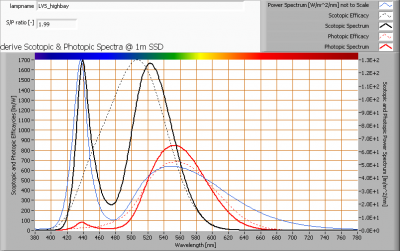
The power spectrum, sensitivity curves and resulting scotopic and photopic spectra (spectra energy content defined at 1 m distance).
The S/P ratio is 2.0.
More info on S/P ratio can be found on the OliNo website.
Chromaticity diagram
The chromaticity space and the position of the lamp’s color coordinates in it.
The light coming from this lamp is at the border of the area designated with class A. This class A is an area that is defined for signal lamps, see also the OliNo website.
Its coordinates are x=0.3050 and y=0.3097.
Color Rendering Index (CRI) or also Ra
Herewith the image showing the CRI as well as how well different colors are represented (rendered). The higher the number, the better the resemblance with the color when a black body radiator would have been used (the sun, or an incandescent lamp). Practical information and also some critics about the CRI can be found on the OliNo website.
Each color has an index Rx, and the first 8 indexes (R1 .. R8) are averaged to compute the Ra which is equivalent to the CRI.
CRI of the light of this lightbulb.
The value of 69 is lower than 80 which is considered a minimum value for indoor usage.
Note: the chromaticity difference is 0.0061 indicates the distance to the Planckian Locus. There is no norm yet that states what the max deviation from white light is allowed to be. A reference with signal lights as a reference is given in the chromaticity diagram.
Voltage dependency
The dependency of a number of lamp parameters on the lamp voltage is determined. For this, the lamp voltage has been varied and its effect on the following light bulb parameters measured: illuminance E_v [lx], the lamppower P [W] and the luminous efficacy [Lm/W].
Lamp voltage dependencies of certain light bulb parameters, where the value at 230 V is taken as 100 %.
The illuminance and consumed power do not vary significantly when the voltage is varied.
When the voltage at 230 V varies with + and – 5 V, then the illuminance varies < 0.1 %, so when abrupt voltage changes occur this effect is not visible in the illuminance output.
Warm up effects
After switch on of a cold lamp, the effect of heating up of the lamp is measured on illuminance E_v [lx], the lamppower P [W] and the luminous efficacy [lm/W].
Effect of warming up on different light bulb parameters. At top the 100 % level is put at begin, and at bottom at the end.
The warm up time is not relevant as the illuminance and consumed power vary less than 5 %.
Measure of flickering
An analysis is done on the measure of flickering of the light output by this light bulb. See the OliNo site for more information.
The measure of fast illuminance variartion of the light of the light bulb
| parameter | waarde | eenheid |
|---|---|---|
| Flicker frequency | 100 | Hz |
| Illuminance modulation index | 1 | % |
The illuminance modulation index is computed as: (max_Ev – min_Ev) / (max_Ev + min_Ev).
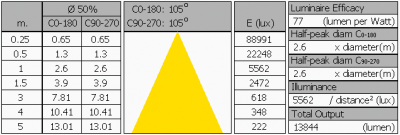
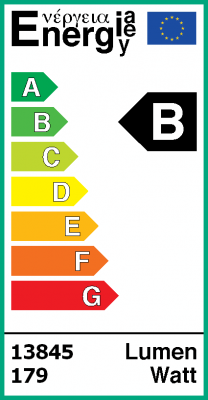

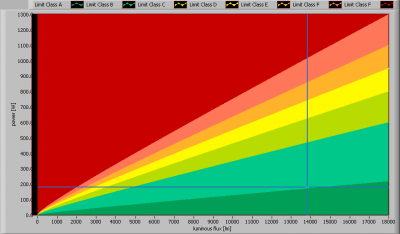
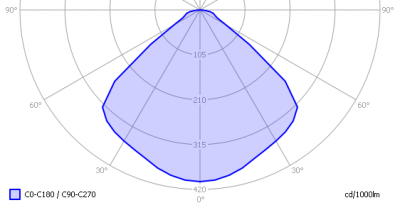
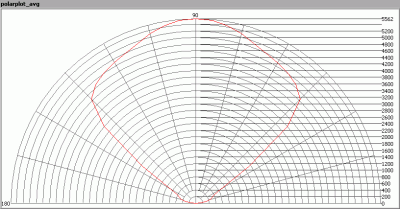
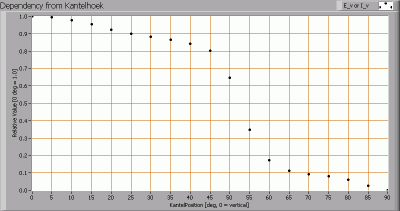
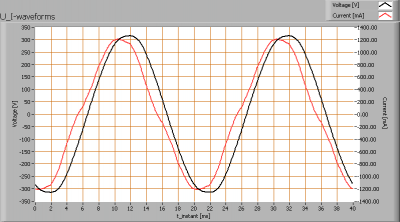
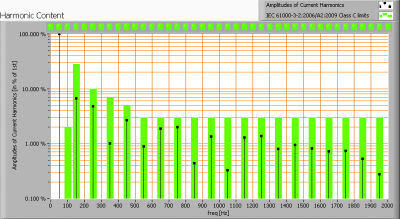
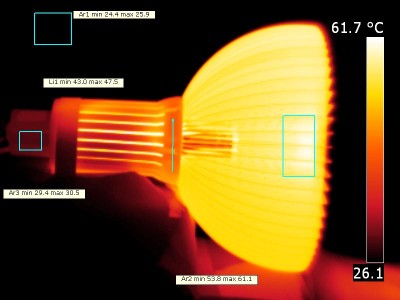
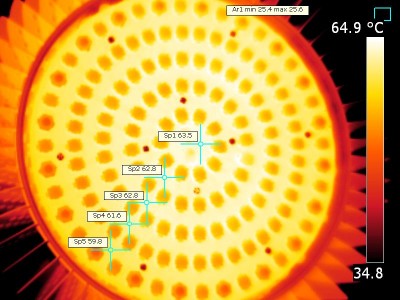
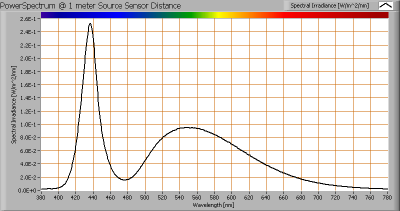
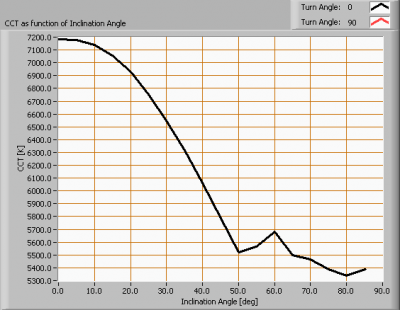
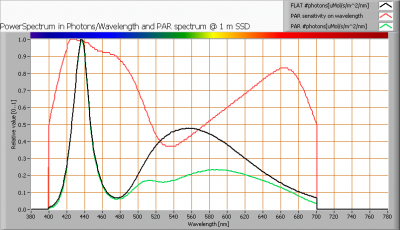
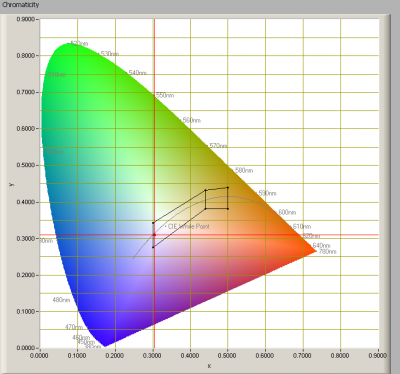
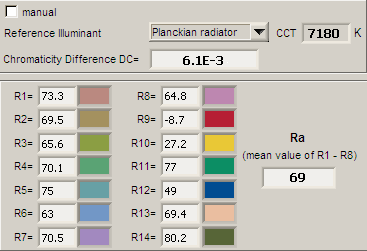
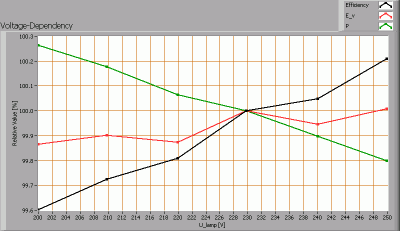
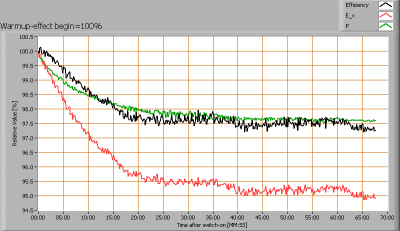
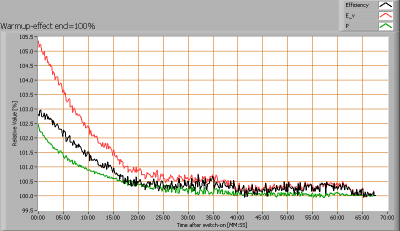
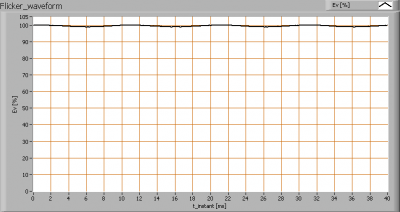
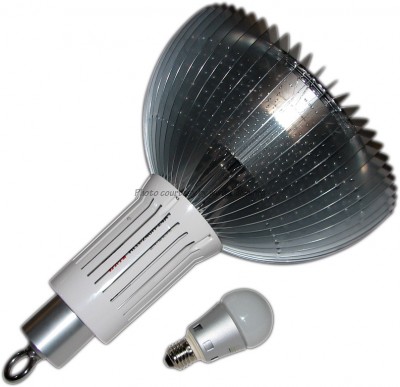



January 20th, 2011 at 12:40 am
i would like price on hy bay fixtures and hy bay 400 watt 230 volt retro fit replacement.